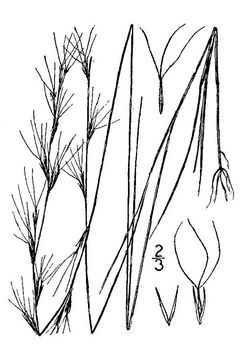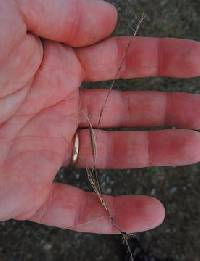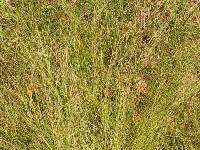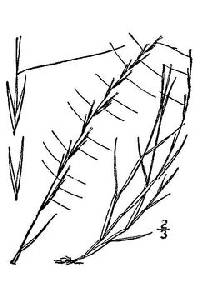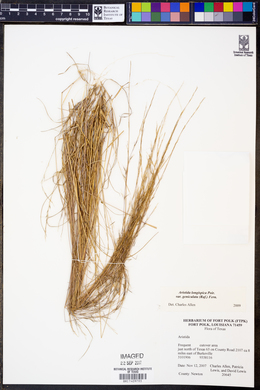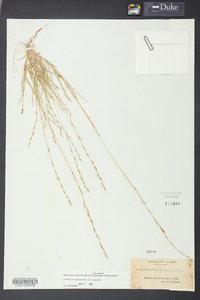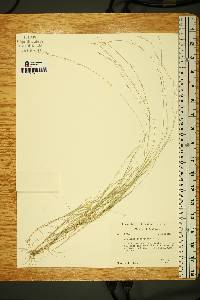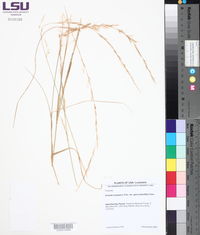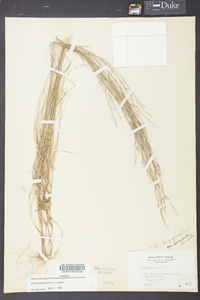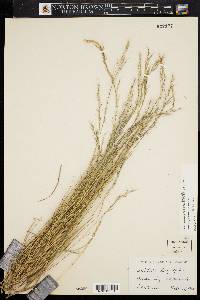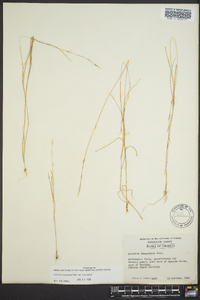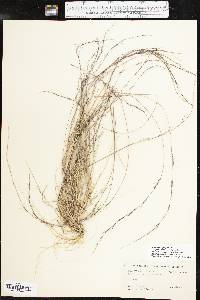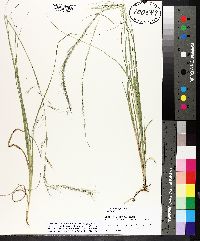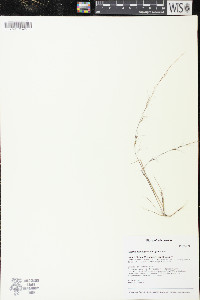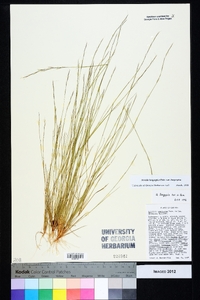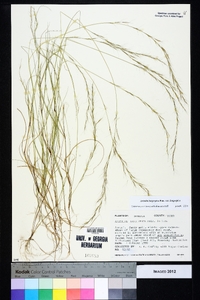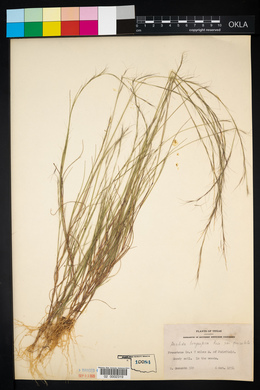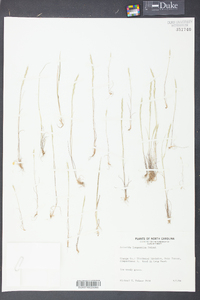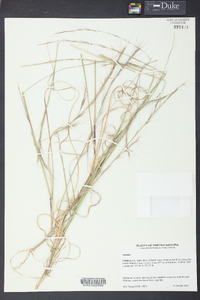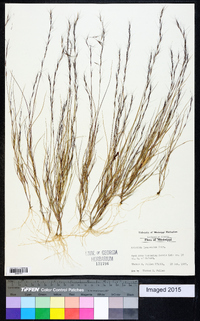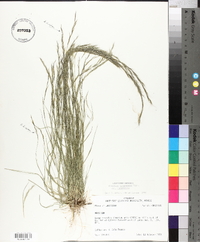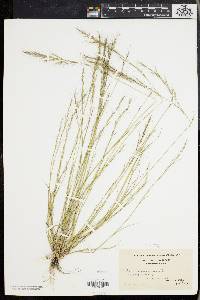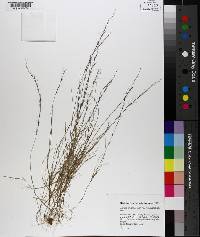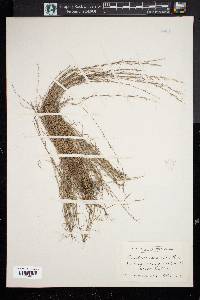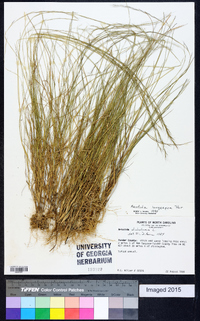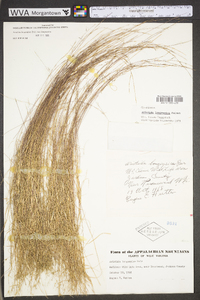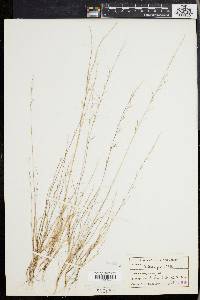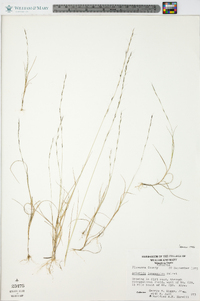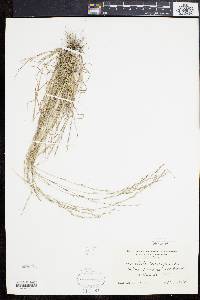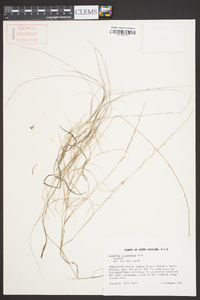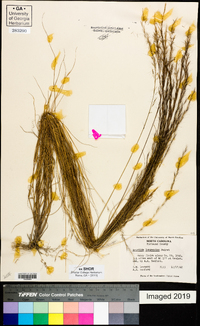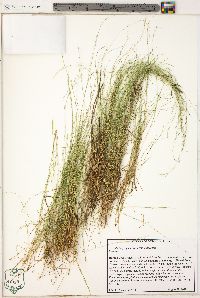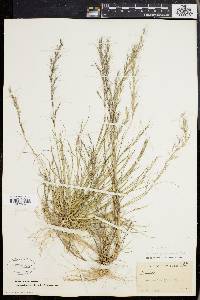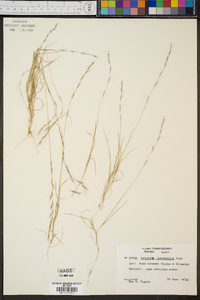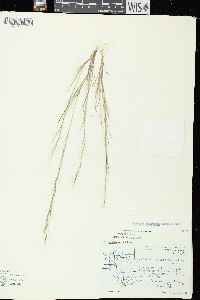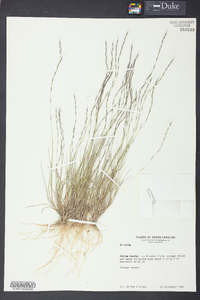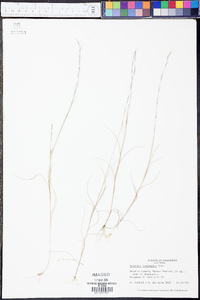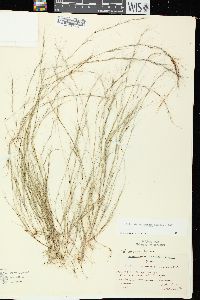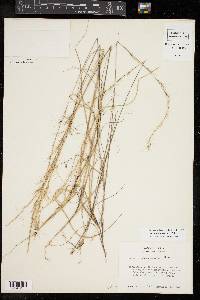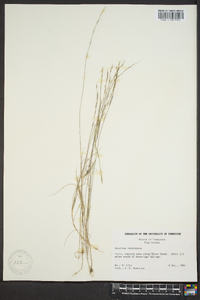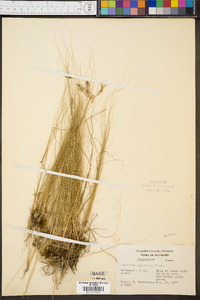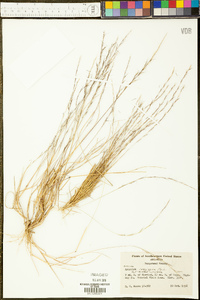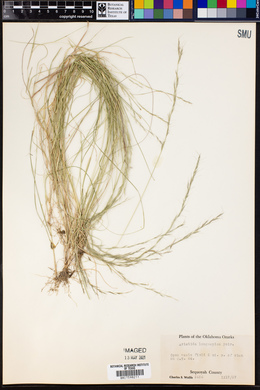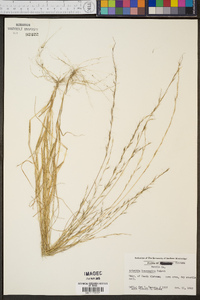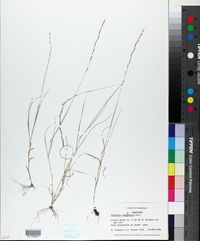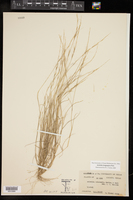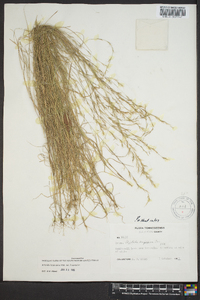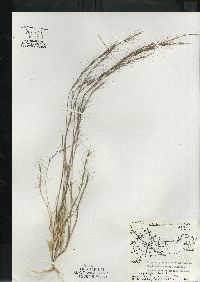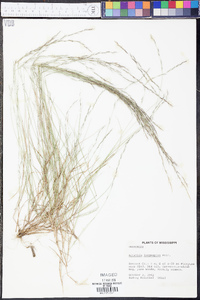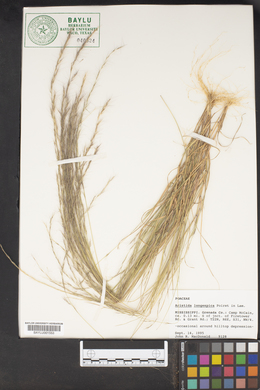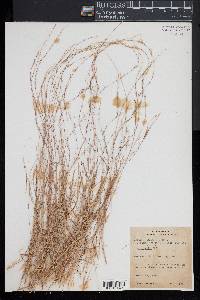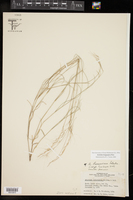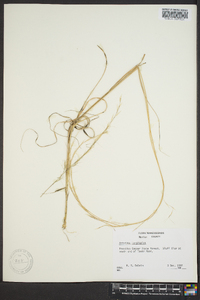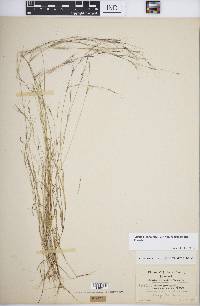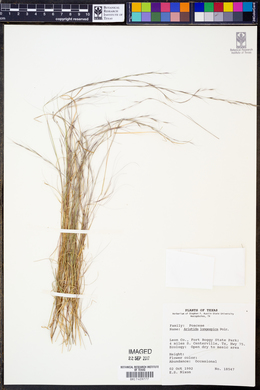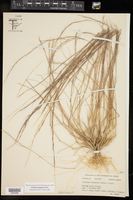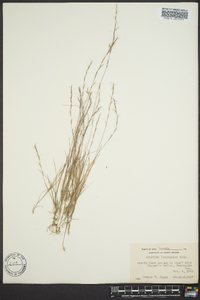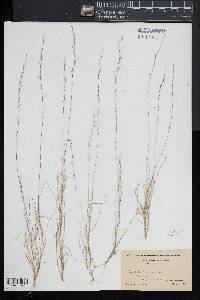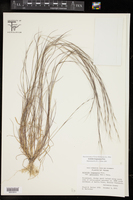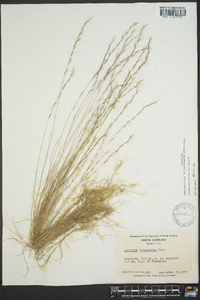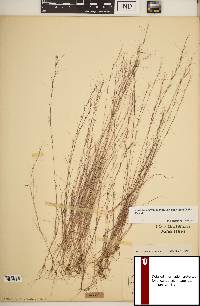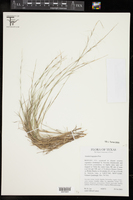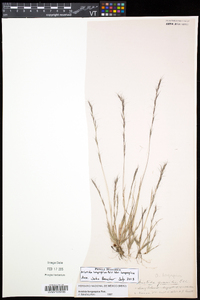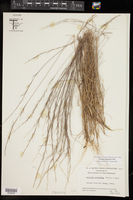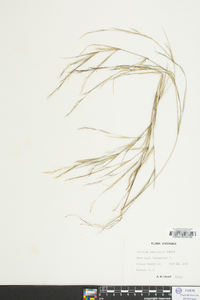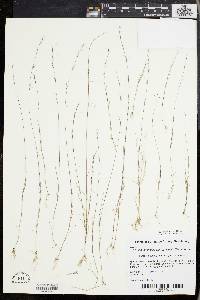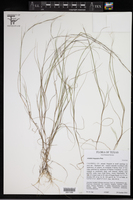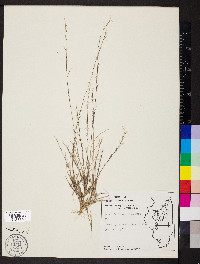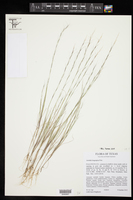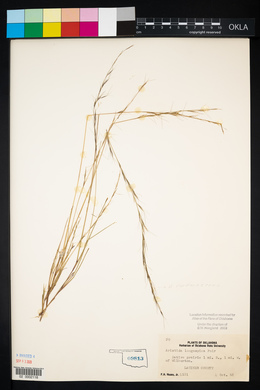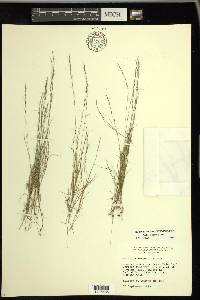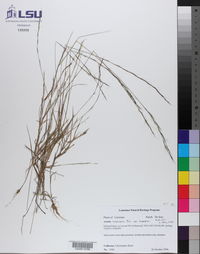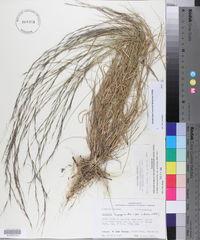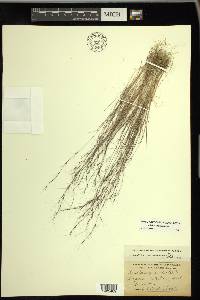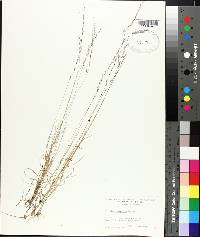Aristida longespica
|
|
|
|
Family: Poaceae
Red Three-Awn, more...slimspike threeawn
[Aristida gracilis var. depauperata A. Gray, moreAristida longispica Poir., Aristida simpliciflora var. texana Vasey] |
Plants annual. Culms 15-65 cm, erect to spreading, often geniculate-based, sometimes nearly prostrate, usually much-branched. Leaves cauline; sheaths shorter than the internodes, not disintegrating into threadlike fibers at maturity, glabrous or sparsely pilose, hairs on the throat sometimes to 5 mm; collars glabrous; ligules about 0.5 mm; blades 5-14 cm long, 1-2 mm wide, flat to loosely involute, light green. Inflorescences usually paniculate, occasionally racemose or spicate, 6-22 cm long, 1-4(6) cm wide; nodes glabrous or with straight hairs, hairs to 0.3 mm; primary branches 1-4 cm, appressed to erect, rarely somewhat spreading distally, without axillary pulvini, with 2-5 spikelets per branch. Spikelets widely spaced to crowded. Glumes subequal, 2-11 mm, 1-veined, acuminate, unawned or awned, awns to 1 mm; calluses less than 1 mm; lemmas 2.5-10 mm, gray to dark purplish-brown, often horizontally banded or mottled, scabrous-hispid or glabrous, not beaked, apices only slightly narrowed, junction with the awns not evident; awns usually unequal, terete and curving up to 100° atthe base, erect to reflexed distally, not disarticulating at maturity; central awns 1-27 mm; lateral awns absent or to 18 mm, shorter than the central awns; anthers 1 and 0.2-0.3 mm, or 3 and 3-4 mm. Caryopses 3-4 mm, light brown. 2n = unknown. Aristida longespica grows along roadsides and in waste places, sandy fields, and clearings in pine and oak woods of southern Ontario and the eastern and central United States. The two varieties have a similar geographic range and are often found growing together. Annual herb 15 cm - 0.87 m tall Leaves: along the culm, the open sheaths shorter than the internodes and hairless or sparsely soft-haired with hairy throats and hairless collars. The ligules are made of hairs to 0.5 mm long, and the blades are light green, 5 - 14 cm long, 1 - 2 mm wide, flat or with margins somewhat rolling toward the upper surface of the midveins (involute). Inflorescence: terminal, 6 - 22 cm long, 1 - 6 cm wide, nodes hairless or with hairs to 0.3 mm long. The primary branches are 1 - 4 cm long, appressed to erect, and sometimes spreading at the tip. Fruit: a light brown caryopsis, 3 - 4 mm long, spindle-shaped, with a linear scar. Culm: erect to spreading, usually bent at the nodes (geniculate) near the base, occasionally nearly prostrate, 15 cm - 0.65 m long, often highly branched. Spikelets: two to five per branch. Glumes: nearly equal, 2 - 11 mm long, thin, single-veined, with a pointed tip that may be unawned or awned (to 1 mm long). Florets: one per spikelet, with three anthers 3 - 4 mm long or one anther 0.2 - 0.3 mm long. Lemma: gray to dark purplish brown, usually horizontally banded or mottled, 2.5 - 10 mm long, spindle-shaped with a slightly narrowed tip, rolled up longitudinally (convolute), rough-hairy or hairless, with three veins and three awns. The awns are usually unequal, curved at the base, erect to reflexed at the tip, with the central awn 1 - 27 mm long and the lateral awns missing or to 18 mm long. Palea: shorter than the lemma, two-veined. Similar species: Aristida tuberculosa is easily distinguished because its awns are twisted into an 8 - 15 mm column that separates into three straight awns at the top. Awns of Aristida oligantha are not twisted at the base and reach up to 7 cm in length. Aristida dichotoma has a 3 - 8 mm long central awn that is twisted at the base and 1 - 4 mm long lateral awns, while Aristida basiramea has a 10 - 15 mm long central awn that is twisted at the base and 5 - 10 mm long lateral awns. Awns of Aristida purpurascens are curved to arching or twisted at the base with the lateral awns about as long as the central one (8 - 25 mm long). Aristidia longispica var. genculata has an 8 - 27 mm long central awn that is curved at the base and lateral awns often 6 - 18 mm long. Flowering: August to October Habitat and ecology: This species is listed as native, but it may not have been here before European settlement. It grows in wet, sandy soil. Occurence in the Chicago region: native Etymology: Aristida comes from the Latin word arista, meaning awn. Longispica means "with a long spike." Author: The Morton Arboretum Annual, 2-5 dm, loosely tufted in small bunches, often branching from the lower nodes; blades flat or involute, 1-2 mm wide, the larger often only 4-8 cm long; panicle ±elongate, to half the length of the plant, very slender, often raceme-like, with appressed or ascending spikelets; axillary panicles much reduced; glumes subequal, 2-11 mm, 1-veined or the first one sometimes obscurely 3-veined; lemmas 3-10 mm; awns terete, to ca 2.5 cm, about equally divergent, or the central one more deflexed. Moist or dry, often sterile or sandy soil; N.H. to s. Ont., Io., and Nebr., s. to the Gulf. Two vars. Gleason, Henry A. & Cronquist, Arthur J. 1991. Manual of vascular plants of northeastern United States and adjacent Canada. lxxv + 910 pp. ©The New York Botanical Garden. All rights reserved. Used by permission. From Flora of Indiana (1940) by Charles C. Deam Indiana Coefficient of Conservatism: C = n/a Wetland Indicator Status: FACU |
|
|
|

